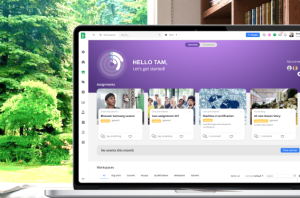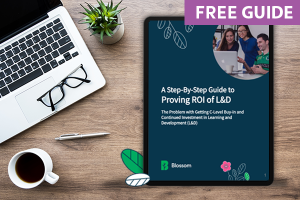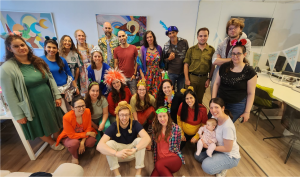Explore the connection between motivation & engagement. Discover theories influencing learner motivation & five strategies to unlock employees’ full potential.
L&D (learning and development) is no longer just about training and churning out training programmes. It’s about driving business success through the continuous development of the business’s most valuable asset: its people.
When employees are motivated to learn, they become the driving force behind the organisation’s success–they’re excited, pay more attention, and are eager to learn.
Since your people are invaluable, investing in strategies to boost learner motivation is essential for creating a positive and productive work environment. By prioritising learner motivation, you can enhance job satisfaction, increase productivity, and promote continuous organisational learning and growth.In this article, discover why motivation is important—not just to initiate learning but also to sustain it. Understand the different motivation theories to create a democratic learning environment, and learn five key strategies to unlock an employee’s full potential.
Develop your L&D programmes by understanding motivational theories
Understanding various theories of motivation equips L&D professionals with valuable insights and tools for designing effective training programs tailored to each employee’s needs and desires. This enhances job satisfaction and boosts employee retention.
By managing these elements, you can cultivate a motivating workplace environment and unleash your employees’ full potential.
First, the basic motivational model explains how individual needs, goals, actions, outcomes, and consequences influence behaviour and motivation at work. For instance, employees might study hard for a work-related qualification because they believe that learning (effort) will result in a good grade (outcome) and value getting good grades.
However, there are several other theories behind motivation. For example:
- Social cognitive theory. According to this theory, motivation is influenced by observing others and the results of their actions. For example, a new employee might be motivated to work hard after seeing a coworker receive praise and recognition for their exceptional performance.
- Interest theory. This theory suggests that individuals are more likely to be motivated and engaged in tasks that they find interesting and enjoyable. For instance, completing a module on social media as it captivates the interest of employees who are passionate about the subject.
- Achievement goal theory. This relates to employees motivated by different goals at work, such as improving their skills (mastery) or outperforming their colleagues (performance). For example, a salesperson might be motivated by mastering new sales techniques to become more effective, while another salesperson might be driven by achieving the highest sales numbers in the team to stand out.
- Attribution theory. This looks at how people explain their successes and failures, affecting their motivation. For instance, if employees think their hard work led to a successful project, they’ll be more motivated to work hard again.
Why motivation is important to learning and engagement
Let’s start by clarifying how motivation and engagement are different. Although they complement each other, motivation drives learners to build skills and knowledge and keep going, while engagement is how involved, enthusiastic, and committed they are to learning.
Both have significant and wide-ranging implications.
When learners aren’t motivated to pursue their learning, they can become stagnant in their roles, leading to lower productivity and quality of work. When individuals feel disinterested in their work or see no opportunities for personal or professional growth, they may become disengaged and unmotivated, leading to decreased job satisfaction and higher turnover rates. Considering that just 23% of employees are engaged at work, addressing the lack of motivation for learning becomes even more critical.

Secondly, a lack of motivation for learning can result in a skills gap and organisations struggling to keep pace with new technologies, such as artificial intelligence or industry changes. This disadvantages them and affects their ability to meet changing customer needs and market demands.
The good news is that most people enjoy their work and feel motivated to learn new skills. When employees are highly motivated, it improves outcomes, including:
- Improved change management. Motivated employees handle change well. They adapt quickly to workplace transformations, like when new software is introduced.
- Enhanced knowledge retention. Learners who are actively involved, focused, and attentive have a deeper understanding and retain new knowledge better.
- Optimised teamwork. When employees feel accomplished and satisfied with their learning goals, positive reinforcement encourages more engagement and motivates them to keep learning.
- Increased creativity. Motivated employees tend to explore novel ideas, experiment with various approaches, and actively contribute to creating innovative solutions.
When it comes to motivation at the start of learning new skills and what motivates employees to continue learning, it’s essential to consider both intrinsic and extrinsic factors.
While intrinsic motivation comes from within a person, driven by personal satisfaction or enjoyment, extrinsic motivation comes from external factors, like rewards or recognition from others.
Extrinsic motivation prompts immediate action but may not sustain long-term engagement in learning. External rewards or incentives, like bonuses or promotions, may initially motivate employees to participate in training programs. However, once the rewards are removed or no longer valuable, motivation to continue learning may dwindle.
By contrast, intrinsic motivation tends to last longer because it involves finding joy in the learning process itself. (Remember the interest theory model?)
Let’s put all this in perspective and consider a sales team undergoing training on new customer relationship management (CRM) software.
To start with, employees might be extrinsically motivated by a cash bonus for completing the training successfully. The prospect of immediate financial reward prompts the team to engage eagerly in the training sessions and complete the required modules.
However, once the bonus is paid out and the external incentive has gone, some employees lose interest in further learning. Without the external reward to drive them, these individuals feel less inclined to invest additional time and effort into mastering additional features.
On the other hand, intrinsically motivated employees will continue to engage with the training even after the external reward is gone. They genuinely enjoy exploring new software, discovering its features, and improving their skills. Their satisfaction comes from the sense of accomplishment they experience as they become more proficient in using the CRM tool
Strategies for building motivation and unlocking an employee’s full potential
Building motivation and unlocking an employee’s full potential involves implementing strategies that address both intrinsic and extrinsic factors. Here are five strategies to help motivate your employees and keep them driven and satisfied in their learning.
1. Listen to understand
Employee listening is an organisation-wide strategy that prioritises actively engaging with employees to understand their perspectives, concerns, and feedback. This approach creates a supportive and inclusive workplace where people feel valued, engaged, and motivated to invest in their own development.
However, according to Sidney Yoshida’s Iceberg of Ignorance, only 4% of an organisation’s front-line problems are known by top management, which includes L&D managers. This highlights the importance of good communication and listening strategies to close this gap and understand learners’ challenges.
What can you do to tackle this?
To help answer this question, listening to learners goes beyond simply hearing what employees say. It involves empathetic listening to their experiences, emotions, and underlying motivations to grasp the full context.
By genuinely understanding employees’ perspectives, you can tailor L&D initiatives more effectively to meet their needs and preferences. This may involve customising training content, delivery methods, or scheduling options to align with employees’ availability and career goals.
This approach sends a powerful message to employees that their voices are valued and respected. It builds trust and rapport between employees and the company and creates a supportive environment for open dialogue and honest communication.
What’s more, listening to understand allows you to identify underlying issues or barriers hindering employee motivation for learning, for example, unclear expectations or conflicting priorities.
2. Empower employees to explore personal projects
Did you know that 43% of UK employees have a side hustle to boost their income?
By giving your people dedicated time and resources to work on personal projects, employees can pursue their personal projects without the pressure of day-to-day responsibilities. For example:
- Providing guidance and mentorship to employees during “innovation hours” allows learners to collaborate with peers, share insights, exchange ideas, and offer project feedback. This builds community and encourages knowledge sharing, boosting innovation and creativity.
- Hosting a showcase event. Allow employees to present their projects to the rest of the organisation. This allows individuals to celebrate their achievements, practice skills in delivering information to others, and inspire others with their creativity and passion.
Give your people the autonomy, resources, and support to explore their interests and passions. It is even more beneficial if these opportunities align with your organisational goals. This alignment can strengthen their sense of purpose and relevance in daily tasks, promoting increased engagement and commitment.
3. Help your people understand the bigger picture
While L&D isn’t solely responsible for helping learners understand broader organisational goals, it plays a vital role by matching learning programmes with the desired new culture and integrating behaviour frameworks.
Help learners connect their learning to broader business goals. Connect learning to real-world scenarios by using case studies, storytelling, examples, and simulations to illustrate how concepts learned in training apply to real workplace situations. Share information about company initiatives, strategic plans, and performance metrics with learners. Help individuals see the connections between their learning efforts and your organisation’s overall progress and success.
4. Celebrate and reward milestones
Personalised emails or social media shoutouts provide learners with tangible proof of progress, boosting their motivation and commitment to learning.
Additionally, celebrating successes and rewarding key milestones fosters a sense of community among learners, as sharing achievements with peers creates connection and support, further boosting motivation and belonging in the learning environment. Consider implementing the following initiatives:
- Organise team celebrations or parties to commemorate significant milestones, such as reaching a collective learning goal. These gatherings allow learners to bond with their peers, celebrate their achievements, and build relationships.
- Offer unique rewards to learners who achieve significant milestones, such as gift cards, extra time off, or opportunities for career advancement. These tangible rewards motivate learners to stay engaged and committed to their learning goals.
5. Offer user-friendly learning experiences
This might seem straightforward, but you’d be surprised at how complex some learning experience platforms can be!
Picture this.
A retail company has just launched a new learning platform for its employees. However, the platform is poorly designed, with a cluttered interface, confusing navigation menus, and slow loading times.
As employees attempt to use the platform, they encounter several issues. They struggle to find the training modules they need due to limited search functionality. And to make matters worse, the platform frequently crashes or experiences technical glitches, disrupting the learning process.
The result?
Learners are frustrated and disengaged. They feel demotivated to participate in learning as the platform’s design impacts their ability to access and engage with the content.
What’s more, the lack of interactivity and personalised learning features fails to captivate employees’ interest or cater to their individual preferences. These barriers to learning cause team members to lose confidence in the training program and a reluctance to engage with future learning programmes–resulting in decreased productivity, lower employee morale, and a lack of skill development among its workforce.
Cue Blossom!
Intuitive user interfaces, customised portals, and gamified features ensure that individuals are across all levels of your company, from frontline staff to C-Suite. Allow learners to easily access information and tailored courses based on job roles and geographical locations right at their fingertips.
- “The platform is very user-friendly; it has a wide range of capabilities, and there is further potential to be gained from using the platform as the breadth of functions is wide. There is real room to grow with Blossom.” –Ilan Cohen, Chief of Learning Development at Super Pharm
Empower learners to connect and engage with others with networking tools and features, such as discussion forums, virtual chat rooms, and collaborative projects.

Boost learner motivation with Blossom
Implementing the strategies we’ve shared here and understanding some of the theories associated with learner motivation can significantly boost motivation and drive positive learning outcomes.
This heightened motivation not only increases interest in starting new learning but also encourages active participation to keep going. As learners feel more motivated and invested in their learning journey, they are more likely to approach challenges head-on and feel confident in overcoming obstacles.
Blossom can help you unlock your team’s full potential by providing tailored solutions and support to boost motivation, engagement, and learning outcomes. Schedule a demo today.








